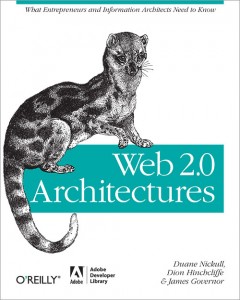If you are trying to decipher web 2.0 related terms, acronyms and buzzwords, you are definitely not alone. It is hard to quantify what exactly a web 2.0 design entails; “I know it when I see it” does not help explaining the characteristic features of modern web architecture including design patterns, core models, reference architectures and solution patterns. “Web 2.0 Architectures” by Governor, Hinchcliffe and Nickull attempts to crack the code of web 2.0 jargon and strives to help reader make sense of this ever changing web ecosystem.

The well written and organized book is divided into eight chapters which discuss design patterns, reference models and architecture artifacts. The web 2.0 patterns discussed in the book includes Service Oriented Architecture (SOA), Collaborative Tagging (folksonomy), Synchronized Web, SaaS (cloud computing), Persistent Rights Management, Mashup, Rich User Experience, Participation/Collaboration, Asynchronous Particle Update, ,Semantic Web Grounding and Structured Information. This categorization helps distinguish salient features of a web 2.0 architecture and help define what richness actually means in a rich internet application.
If you have been working in the field long enough, the meme map on page # 63 will help skimming through chapter 3 (which contains web 2.0 example sites) so you can get to the core of the book. Chapters 4 to 7 discuss specific patterns for web 2.0, models, and reference architectures. As mentioned in the book’s title as well as title of this review, “web 2.0 architectures” is focused on big picture architectural overview of the Web 2.0. Even though it’s not a 10000 ft. abstract overview whitepaper, it also does not converse nitty gritty details of building a 2.0 app using jquery and node.js. This text is about concepts, models, reference architectures and common recurring themes in web 2.0 sites. It does not concern itself with specific technologies and implementation details but rather talk about the common paradigm. Therefore, if you are considering it as a cookbook/recipes book for web 2.0 applications, you will be sorely disappointed. However, if you are a web engineer / architect or a technologist interested in the underlying design patterns and attributes of web 2.0, this book is for you.
